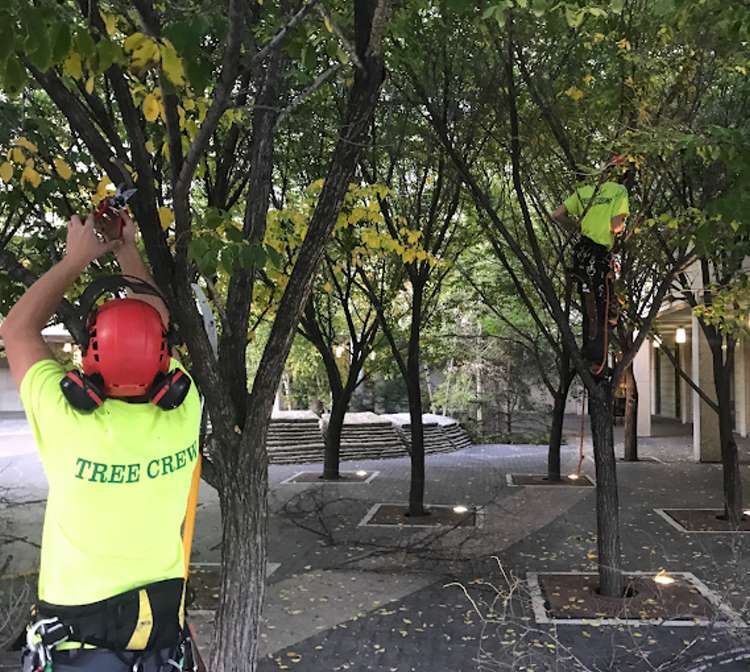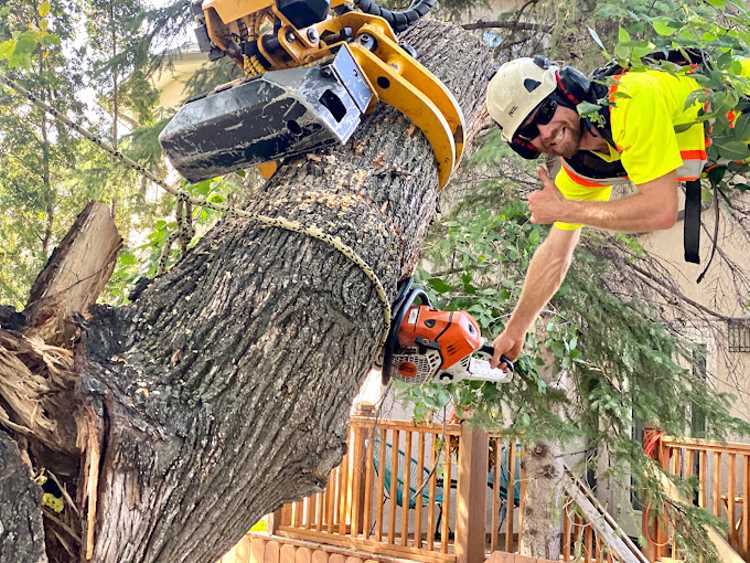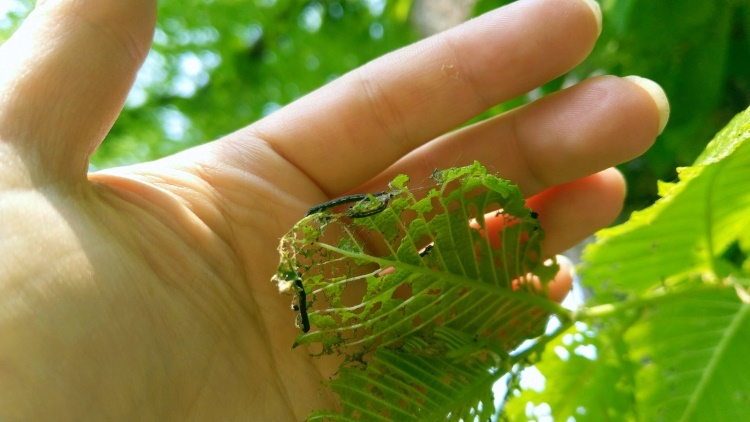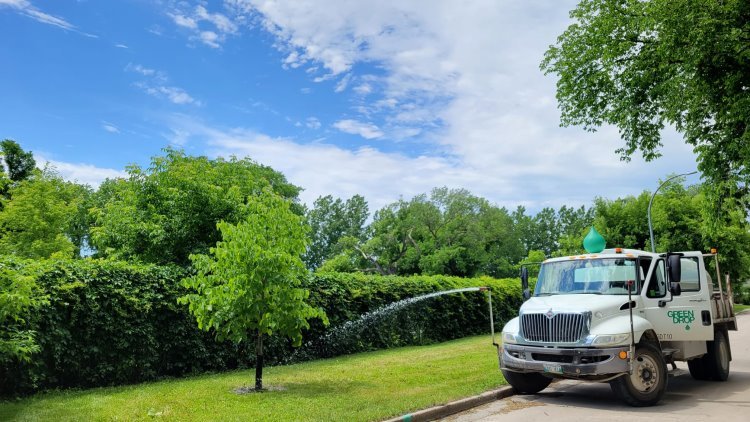Tree Care Packages
-
RootBoost™️ - Deep Root Fertilization
-
2 Targeted treatments for insect and disease control
-
Comprehensive landscape assessment
-
6% Discount when prepaid
-
RootBoost™️ - Deep Root Fertilization
-
3 Targeted treatments for insect and disease control
-
Comprehensive landscape assessment
-
8% Discount when prepaid
-
RootBoost™️ - Deep Root Fertilization
-
4 Targeted treatments for insect and disease control
-
Comprehensive landscape assessment
-
10% Discount when prepaid
You need tree care that keeps your yard beautiful and trees healthy. At Green Drop, we’ve built a team of 14+ International Society of Arboriculture (ISA) Certified arborists. They’re ready to share their passion and experience to keep your trees & shrubs looking their best.
We offer services customized to your yard’s needs, including:
- RootBoost
- Plant Health Consultation & Diagnosis
- Tree & Shrub Pruning
- Tree & Shrub Trimming
- Tree & Shrub Removal
- Tree Planting
- Insect & Disease Control
What does Green Drop do?
- Personalized, custom tree care
- Year-round protection and maintenance to keep your trees in top shape
- Uses top-of-the-line technology, training, and equipment to care for your trees & shrubs
- Makes it easier than ever to get professional tree care
Get back to enjoying your outdoor space and turn to Green Drop for beautiful trees.
Benefits of Season-Long Care
Healthy trees and shrubs are an important part of any landscape. They can keep your yard looking beautiful, save you from future maintenance costs, and even increase the value of your home.
Regular tree care from our expert team can make it happen. Get your estimate today.
Green Drop Tree Care Services
Healthy trees and a beautiful yard are yours with Green Drop’s tree care services*. Let our team of passionate and knowledgeable arborists help you make your yard a tree paradise. From spring pruning to over-winter maintenance, you can turn to our team for a full array of services.
With over twenty years of experience and 50+ full-time staff across our locations, we know all the tips, tricks, and trends to keep your yard vibrant. You can start enjoying the view with our team on your side for residential, commercial, and municipal tree care. Your trees will thank you!
*Service availability may vary by location
RootBoost Keeps Your Trees Looking Their Best
When you need regular tree maintenance, turn to RootBoost for year-round fertilization. This deep-root fertilizer provides nutrients directly to the roots of your trees and shrubs, keeping them growing strong during every season.
Our specialized treatment is excellent for:
- Root development
- Stronger disease resistance
- A surplus of nutrients readily available to speed up new growth

How Does RootBoost Work?
Our RootBoost program is done seasonally, usually in the fall, to keep your trees healthy and strong during the winter. When you schedule your RootBoost service, our team will come to your home and inject liquid fertilizer about six inches below the surface. Since most tree root systems start between four and eight inches down, this is an optimal spot for fertilizer.
Each arborist knows the specific application rate for our process, which is done systematically. They come armed with the knowledge of each tree species they encounter, so they know when to adjust their application process to best care for your trees.
Why Do We Deep-Root Fertilize?
After countless years of working with trees, we’ve seen plenty of tree care methods come and go. What hasn’t changed is our passion for beautiful trees. We’ve learned that fertilizing at the root keeps trees stronger and healthier.
Our team practices Integrated Pest Management (IPM) to ensure that all our decisions are science-backed and leave the least negative environmental impact on your property. That’s why our RootBoost system targets the root system directly, encouraging proper growth patterns, producing strong, healthy trees with brighter and thicker leaves.
Additional benefits include soil aeration, more aesthetically pleasing trees, and protection from pests and disease. Because this is a preventative measure, you emulate optimal growth conditions for your trees, and they get to show off their best angles.
Book your Root Boost service now
A Full Range of Arboreal Services
While Green Drop’s RootBoost system will make your trees & shrubs beautiful, we offer various other services, from pruning to health consultations. Our offices currently offer our RootBoost program, but some other services are not available everywhere.
You can use our Plant Health Consultation and Diagnosis services in Calgary, Red Deer, Edmonton, Saskatoon, and other surrounding areas. In Winnipeg and Regina, we offer the full array of arborist services detailed below. We aim to provide all programs in our service area as soon as possible!
Our team of arborists is one of the most robust in Canada. You’ll find 14+ International Society of Arboriculture-certified Arborists, an ISA Municipal Specialist, an ISA Master Arborist, and several other licensed arborists and pesticide applicators to meet your wide range of tree care needs. We’d love to hear from you if you’re wondering which services are available at which location.
Tree & Shrub Pruning and Trimming
Ensure that your trees can live up to their potential with regular pruning. Our experienced arborists are invested in the longevity and healthy growth of your trees and shrubs. We make it easy by offering formative pruning for young trees and structural pruning to keep hazards at bay and keep mature trees healthy.
Why Should You Prune Trees?
Regular pruning encourages trees to grow in the best shape for the tree, prioritizing new growth and making it easier for trees to take in nutrients. Doing this means longer life for your trees.
Additionally, trimming means removing dead branches or diseased areas of trees. This process could save a tree and terminate the potential for damage to your family or home if something were to fall.
Tree trimming effectively keeps your yard looking its best while maintaining tree health and safety.

What Does Our Pruning Service Include?
Green Drop takes pruning needs very seriously. Our arborists have extensive training and experience with trees in the area, so they will examine your yard to find the areas that need care. Any tree pruning from our team is done following ANSI A-300 Pruning Standards to ensure quality and consistency across your yard.
Tree & Stump Removal
Removing stumps and trees from your yard on your own is challenging. If you need a hand, we’re here to help. Our certified arborists undergo special training to undertake these removals, using heavy-duty equipment to tackle potentially hazardous removals.
Why Do Tree Removals Happen?
Tree removals don’t only happen when you have an old stump or a dead tree, though these are very common. Instead, you might find that one of your trees has grown too large for your yard. Sometimes severe storm damage is a reason to remove a tree.
You might even need to remove a diseased tree to keep it from infecting the rest of your yard. Whatever the need, our removal team knows how to keep your yard looking its best.

How Does Green Drop Do Tree Removals?
As we’ve mentioned, our arborists are certified with the ISA. They undergo extensive training to use our specialized equipment before performing tree and shrub removals.
After our team examines your property and assesses the trees that need removal, we will bring in our equipment to carefully remove trees from your property. We can provide safe and efficient services with aerial trucks, climbers, and large-capacity wood chippers.
Tree Planting
You likely want to make your outdoor oasis inviting, which you can accomplish by adding exciting diversity and native trees to your space. Our tree planting services are a great way to make your yard more beautiful. We’ll help you decide on the size and type of tree, so you’ll never have to worry about choosing the perfect ones alone.
Why Are Professional Tree Planting Services Good?
When you work with a tree service company, you get access to expert knowledge and better equipment for your tree services, so you don’t have to figure out all the logistics for planting in your yard.
You don’t have to worry about improperly planted trees. We’ll examine your yard to find the best spot to plant the first time. Additionally, professional planters understand how to choose the best site for your new trees because they test the soil, examine your yard, and know the techniques that won’t damage your property or the new plants.
We dedicate ourselves to outstanding care for each tree we work with. So you can expect a delicate, expert touch that keeps your yard looking fantastic.

What Do Tree Planting Services Include?
We offer a variety of planting options for trees. We start with smaller containers at 10 gallons, moving up through 15, 20, and 25-gallon containers or wire baskets as needed. All planting prices include the tree, mulch, initial watering, and staking (if required).
The team also provides a 1-year 50% replacement warranty for installation defects to ensure that any trees we plant for you are healthy and grow well. To further encourage healthy plants, our certified and insured team members will follow ANSI A-300 Planting Standards so your tree gets the best possible start.
If you’d like to learn more or get suggestions from the team, we’d love to hear from you. Our team is always ready with great options for your area.
Plant Health Consultations
We protect your plants from pests and dangerous diseases with thorough yard exams and in-depth knowledge. Our annual programs keep pests away and any worrying conditions at bay because our specialists are tree experts and know how to treat insects and illnesses' specific effects on Canadian trees.
Insect Control
Many species of insects can damage your trees. Killing leaves, stems, and branches and ruining the beauty you’ve cultivated in your space. Controlling these pests is essential to maintaining a healthy, sustainable outdoor space. Green Drop will help you develop a management program that works for your yard and prevents infestations.
We’ll help you plant suitable varieties in the best areas to discourage insects from invading your trees and causing long-term damage. If we ever find a problem, we’ll treat it immediately to keep the nuisance from killing trees or causing other damage.

Disease Control
Microorganisms or environmental stressors often cause diseases that affect plants and trees. Usually, the microorganisms are bacteria or fungi, while stressors can include drought, pollution, or unseasonable temperatures. Working with a professional arborist means you can diagnose the issue more quickly and then begin a program to treat any problems.
Our arborists are certified and keep up-to-date with the latest trends and health concerns for tree populations in the area. So we’re always on the lookout for any issues that could arise. With our science-backed management practices, we’ll keep your trees looking tip-top.
Municipal Tree Care
Finding tree care services that work for a large community can be hard work. So Green Drop makes this easier by bringing all your arboreal service needs under one umbrella. Our management services will help you inventory your trees, watch for any disease, and plan where your next tree will go.
Our ISA-certified team, including an ISA Master Arborist, is ready to improve your community with healthy and beautiful trees without exceeding budget. We utilize state-of-the-art technology and equipment to ensure you can plan any project and maintain your urban forest for the future.

Benefits of Tree Care and Maintenance
Caring for your trees and shrubs provides many benefits, not the least the time and money saved by maintaining your trees to avoid safety hazards and disease. With Green Drop as your tree services experts, you’ll reap the rewards of tree maintenance year-round.
Improve Tree Health
Having an arborist prune and examine your trees for disease is a great way to keep your trees growing their best and your yard in top shape. With this maintenance, you’ll experience new growth more quickly.
You will also be able to spot any issues early because there won’t be dead branches in the way, keeping the healthy cycle moving. Our ISA-certified arborists understand what steps are needed every time they visit your property, so your trees are in good hands.
Boost the Curb Appeal of Your Home
For many, aesthetics are an essential factor in the appeal of any outdoor space. So you likely want beautiful trees to improve your yard if you’re considering selling or just want to impress the neighbours.
Environmentally Sound
Green Drop is environmentally conscious, and so are many of our clients. We believe that beautiful trees are essential to our environment. Tree care services enable you to keep the disease from spreading and keep necessary nutrients from being fully depleted so your yard stays beautiful.
Healthy trees can further benefit the environment because they help reduce energy costs and improve the weather.
Remove Safety Hazards
Last but not least, tree maintenance provides a safety net for yourself, your family, and your home. Dead branches can fall, damaging property or potentially injuring someone, so adding pruning to your tree care services will help you keep safety top of mind.
Relying on the skills of the Green Drop arborists means you don’t have to worry about climbing trees to trim branches or constantly keeping an eye out for problem areas you might have missed. Our team knows what to look for and will stop issues before they take root.
Plant Disease Diagnostic Laboratory
Worried a disease might have infected your beloved trees? Turn to the diagnostic lab in Winnipeg for testing. Our skilled team and highly trained pathologists will work together to test any suspicious or suspected infected materials and get your greenery back on track.
Our goal is always to diagnose early and treat with speed and efficiency to ensure that your trees have a long life. We follow a four-step process that includes:
1. Sample Collection – Gather samples of the affected plant material per our guidelines.
2. Submission – Deliver or send the samples to our laboratory.
3. Expert Analysis – Our pathologist and team meticulously analyze the samples using proven methods.
4. Accurate Results – You receive comprehensive reports detailing the diagnosis and recommended action steps.
Whether you’re worried about Dutch Elm Disease, Anthracnose, Black Knot, or any number of other common or hard-to-track diseases, we’re ready to help. Once we’ve collected data and found results, we curate a custom plan to treat any issues before they cause long-term damage.
Never worry about tree health again; turn to Green Drop for diagnostic testing and hands-on care that leaves only vibrant trees behind.
Emergency Services
When severe weather strikes, you need tree care professionals who can be there quickly. Green Drop has developed emergency services to help you when trees endanger your property. We take hotline requests 24/7 and work hard to get our experts to your home as soon as we can.
We’ll help when you need:
- Tree Removals
- Storm-Damaged Tree Assessments
- Tree Pruning and Trimming
- Emergency Support Systems
Our coverage protects even the most remote areas, so you can count on us for safe and effective care no matter where you are. We’ll ensure there are no delays that keep you from enjoying your outdoor spaces or damaged limbs that put our property at risk.
Green Drop Cares for Your Trees
Choosing professional tree care services can sometimes get overwhelming. There’s a lot that goes into selecting the right services and company. Green Drop handles all of the significant hurdles that come with tree care with on-site service.
Whether you’re residential, commercial, or municipal, we design a personalized program catered to proactively protecting your trees year-round. We pride ourselves on quality work from qualified arborists because we care about the health of your trees.
Get in touch today for a free estimate and get on the path to beautiful trees.

